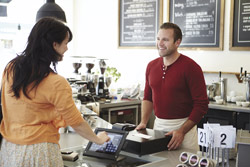By Alexander Gad

The boundaries that once prevented a traditional brick-and-mortar store from reaching their full potential began to diminish when the tablet was introduced. The tablet revolution has not just reached the retail industry, it has become one of the most essential elements shoppers have come to expect.
Many retailers are adopting this in-store technological advancement, and realizing how greatly they can enhance brand experiences with this development. Tablets and their applications possess such unlimited potential for changing the way people shop and spend, that in a matter of time it will be challenging for a store to compete with others if they do not have this mobile device working for them. This technology has transformed society’s ability to understand and access goods.
Product Display/In Store Information
A tablet provides a creative way for small retailers to expand their product offerings without having to keep all the merchandise on hand in the store. Many retailers do not have space for their entire inventory, but a tablet as a “virtual catalog” offers the full range of products online. It is a great way for potential customers to experience as much of the brand as possible. A tablet digital display is the easiest and most affordable way for retailers to create, display and manage product information, including specs, images and videos. Compared to traditional signs, a tablet is compact in size, portable and the displayed content can easily be changed and updated. This is ideal to broadcast a limited time promotion or in store exclusive. A tablet can even be used for cross promotion, to advertise partner videos and sales.

In Store Mobility
Having tablets available for both retail associates and customers offers a new level of service. With a tablet in hand, your customers are empowered to scan items for a running total as they shop, while guided menus can help them locate a particular product all on their own. They can also create gift registries quickly and easily, access product information as well as access personalized special offers. It is putting self-service in the hands of your customers. This reduces the wait at the checkout stand, and frees up employees time for other work. According to an Adobe survey of 400 U.S. consumers, 25% said they “would research online before making a purchase.” Therefore, having a tablet available for customers brings them that much closer to a purchase. A tablet for an employee is equivalent to a providing them with a personal manager because it can train them and instantly answer questions regarding inventory and product details.
In-store payment processing
POS hardware is slowly being replaced with mobile devices. The tablet is the new cash register, and it is the cornerstone piece of retail technology. It provides numerous advantages to businesses in the form of higher potential sales, lower costs and greater opportunities for customer/ employee engagement, while giving them the flexibility and mobility they need. Tablet applications are actually preferred by employees because they can use one device to instantly process payments, create customer profiles, process gift cards, lookup inventory that is related to the product being purchased for target recommendations and email or wirelessly print receipts. Low profile tablet based POS also frees up limited counter space and eliminates any payment line which helps free up floor space for merchandise, benefiting the retail store and the shoppers. Providing tablets for sales associates on the floor is one of the smartest moves a retail shop can make, especially a brick-and-mortar store.

Customer feedback
Knowing what customers think of their experience in your store is vital information for bettering your business. It is recommended to acquire this data when it is still fresh, either in the midst of or immediately following their visit. An advantageously placed interactive tablet kiosk is an ideal way to collect this information. It is a cheaper, simpler and sleeker way for retailers to offer their guests any survey or comment card that asks the questions they want answered. It is hassle free and more engaging as an interactive application because the feedback is completely genuine and thorough, and customers can control how long the engagement will last. It is cost effective to the retailer because it does not waste the employee’s time trying to obtain this information. With these interactive displays, stores can collect information on customers, and offer promotions on items the customer has shown interest in, which appeals to both the customer and the retailer.

